Archive for December, 2014
Lucy Culliton survey exhibition at Mosman Art Gallery
Dec 15th
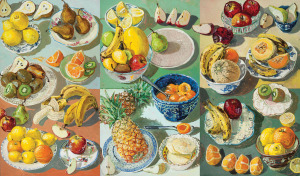
Summer Fruits, 2000, by Lucy Culliton
As the tens of thousands of people who enjoyed it already know, the recent Lucy Culliton survey show at Mosman Art Gallery was quite wonderful, and a great tribute to an artist whose contribution is already substantial but who will go on to do so much more.
In September (2014), I was lucky enough to sit with Lucy’s dad Tony Culliton at a wonderful lunch to celebrate the exhibition, titled The Eye Of The Beholder: The Art Of Lucy Culliton. After lunch, Lucy took to the stage with compere Simon Marnie and artists Euan Macleod and Peter O’Doherty in a conversation that shed light on Lucy and her work.
Here are some observations from the notes I made that day:
Lucy’s menagerie: People are always interested in Lucy’s love of animals, and the number of creatures she has gathered around her. Lucy said she currently has 42 sheep, two pet cows, a pet pig, four dogs, a fowl and a magpie. She recently looked after a wombat while taking it to an animal rescue person.
Lucy’s new studio: “I have just purpose-built a big studio [on her farm, Bibbenluke Lodge, at Bibbenluke, NSW]. I was struggling in an existing shed.
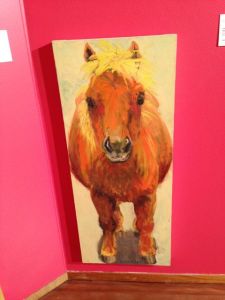
How can you resist this gorgeous horse painting by Lucy Culliton?
But it wasn’t big enough so I have just built a really big, fantastic studio.”
School: “I was hopeless at school. I dropped out at the end of Year 10. I took a while to mature.” Lucy worked in graphic design until the age of 27 when she enrolled in the National Art School in Sydney. One day, the veteran art dealer Rex Irwin addressed the students at NAS, telling them that for every 100 of them, only one would achieve. “I felt I was chosen!”, Lucy said. At this point, Euan Macleod chimed in: “We were told it was one every two years.”
Dyslexia: “I’m quite dyslexic. Working as a designer did not suit me. I didn’t know what to do. I just wanted to be a painter but I wasn’t strong enough to start. I needed an in. I needed a peer group. I kept horses at the Showground also, so I wasn’t a drinker.” Lucy made a bit of money while she was at art school by riding other people’s horses at the old Showgrounds, now Centennial Parklands Equestrian Centre. “I love horses,” she said.
When did you realise you were an artist? The artists had a question about when they realised they were an artist. This brought out a lovely bit of light banter.
“I’m hoping next year,” said Euan, who is a very prominent Australian artist.
“I think it was about 4.30 on a Tuesday, ” said Peter, ever the clown.
Lucy’s answer was illuminating.
“I haven’t painted now for two months and I feel like I am not a painter.” Various life issues had kept her from the studio. Lucy has also told me in the past that, once she has finished painting for an exhibition, she normally goes into a semi-dormant stage as far as her work is concerned.
Euan added: “What Lucy says is true. You get pulled away from your work. Sometimes you feel you aren’t getting enough time to think about what you’re doing and you get back to the studio being a sanctuary and the studio being a special place.”
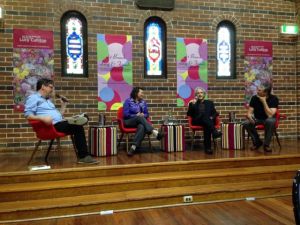
Simon Marnie, Lucy Culliton, Peter O’Doherty and Euan Macleod
Routine: “I love routine,” Lucy said. After feeding all her animals, she’s in the studio by 9am. “After lunch, I decide whether to go back to the studio or do some gardening or mow the lawn or something like that.”
Peter said he and his artist wife Susan O’Doherty tend to work until dark in their shared studio at their home in Coogee. They then put out the work on the coffee table, watch TV and have dinner and keep going.
Relaxation: It sounded like all three artists are incredibly hard workers. Euan said he’s not very good at relaxation, and Lucy said all her trips are painting trips. “I don’t go on holidays,” she said.
On finding her property in rural Bibbenluke, which is a former trout fishing lodge: “I just found ‘Lucy-land’,” Lucy said. “I found the place that suited me. It just happens to be six hours south of Sydney. All the outdoors things suit me. The house is a bit run-down, so it’s comfortable for my animals. I also found Sydney is far too social. It takes a lot to get me away [from Bibbenluke].”
Art prizes: There was a funny moment when we learned Lucy’s work, which is hugely popular and widely collected, was recently rejected from the Bega Art Show!
Euan said he missed Lucy at NAS, where he taught, by a couple of years. “Everyone was talking about this student who was there a couple of years before.”
Finding home: Lucy said she would still be at Bibbenluke Lodge “until I’m 80”.
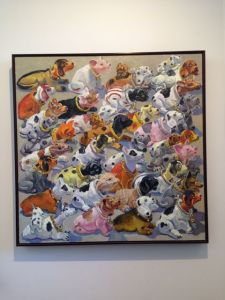
A Lucy painting from her Mosman Art Gallery retrospective exhibition
“I’ve just arrived at where I’m comfortable,” she said. “It’s a place that feeds me full of ideas and (where) I can make my work. And it’s a beautiful garden. It’s the best place in the world.”
On advice for emerging artists: “Don’t take any advice. Just do what you want to do,” Lucy said.
Elizabeth Fortescue, December 15, 2015
Elisabeth Cummings: on view at Shoalhaven City Arts Centre in Nowra until February 21, 2015
Dec 14th
Tom Carment on drawing, bushwalking and the Dobell Australian Drawing Biennial
Dec 9th
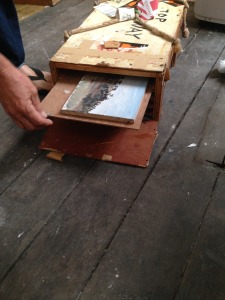
Tom Carment with one of his portable painting boxes
Tom Carment is one of the 10 artists selected by curator Anne Ryan for the Dobell Australian Drawing Biennial exhibition at the Art Gallery of NSW. I popped in on Carment at his home on a quaint and atmospheric laneway in inner Sydney. We were going to talk about drawing and bushwalking. Carment’s new book, Seven Walks, Cape Leeuwin to Bundeena, has just been released with gorgeous photographs by Michael Wee to accompany Carment’s drawings and text. That, along with his current exhibition at King Street Gallery on William, has been keeping Carment somewhat busy this year.
Artwriter: You’ve got numerous things happening: the book, the Dobell drawing exhibition, and your own exhibition at King St.
Carment: They’ve got 128 of my little watercolours (at the AGNSW show). I’ve done quite a lot of jacaranda paintings recently. And Neilson Park and Coledale (and other locations in city and country).
Is all this a coincidence, or was it planned to happen together?
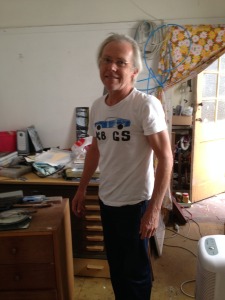
Tom Carment
It’s been kind of hectic. Nearly four years ago Jan (Carment’s wife Jan Idle) said “let’s do the Cradle Mountain Overland track as a family”. I think Matilda was 11 and Fenn was 16 and Felix was 18, something like that. And she really planned it well because we did it with carrying our own food in, and tents. We did the six day walk and this kitchen table was covered with ziplock bags and we marked them off every day and we planned all the food. Michael Wee is a friend through Crown St Public, our kids went to school together. Andrea his wife designed the book. We have an ex Crown St Public School parent coffee still, even years after our kids have gone on to high school and beyond. We still meet up at the Belgenny Café at Taylor Square. I was telling Michael silly anecdotes about our adventures on the walk – getting completely wet, me getting a leech inside my mouth, things like that, and he loves walking and photographing landscape. A few weeks later he came back and said, “I’ve got a really good idea, why don’t we do this book together, walks in Australia?”. He thought it was a good hook to hang a beautiful book about Australian landscape. We weren’t really experienced bushwalkers. I’ve always gone out to paint in the bush, but not camping out overnight with my own tent and my own food; usually I go to the Royal National Park, and I’ve gone camping with the family where you pull your gear out of the back of the car and walk 25 metres and put up your tent at Honeymoon Bay or somewhere. So it was a learning experience for me. Michael and I did all the same walks, but we didn’t do them all together. (Carment undertook some of the walks with other friends.) I tried to incorporate some of the conversations we had on the walk. Because when you go on a walk you have conversations you wouldn’t have in the rushed schedule of everyday life. Especially with our own kids, they started quizzing us. They asked Jan and I about our lives. “What were doing when you were 16?”, that sort of thing. That was really nice. You don’t talk all the time when you’re walking; you might walk for an hour with someone and not say anything. When you come back from a longish walk I think the anxieties you had are put in perspective and liitle things you thought were terribly important aren’t so important any more. I think it’s very kind of refreshing.
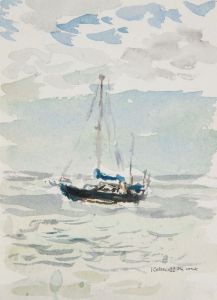
A work by Tom Carment
You’ve always gone into the bush to paint. Did you enjoy the long walks and camping?
Yeah I really enjoyed it, except sometimes it was a challenge to get in my painting with the walking. Michael will walk along and see something and stop and take a photo of it. The sort of paintings I have in this book, of drawings or paintings, they start with a line drawing and I add the watercolour, so you could call them drawings. It takes me about 20 minutes, half a hour, to do one. If I was walking with other people, I might sneak one in during morning tea break, at lunchtime perhaps I could do a watercolour, and once I’d set up my tent in the late afternoon, before it got dark I’d rush out and do some painting and when I first woke up in the morning I’d rush out and try and do a painting then. So I had to really make the most of my time.
Some of the walks were already familiar so I had a greater wealth of watercolours to draw from, for example the Otford – Bundeena walk. I first did that walk about 35 years ago. And the Cape to Cape walk, because my partner Jan is from WA, we’d holidayed on that coast before. We used to go across to WA to see Jan’s parents and we’d go down to the mouth of the Margaret River which is half way up the Cape to Cape walk; it’s day three of the Cape to Cape. And when we’d we stayed there we’d gone and done bits of the Cape walk.
One of the challenges is you can’t take too much?
I also had all the breakfasts for the family, so my weight diminished over six days. I learned to take just an A5 and an A6 size pad and a little Tupperware container with my watercolours and a couple of little enamel plates which I put face to face. I use tubes and then I use these pens which are permanent sort of things. They dry quite quickly and when I put the watercolour wash on they don’t blur out.
You’re in the first Dobell drawing biennial at the Art Gallery of NSW. (The biennial this year replaced the former and well-loved Dobell Drawing Prize, in which Carment was hung three times and was rejected 17 times.)
I guess I’m lucky, it was my time. I let (Anne Ryan) pick the eyes out of what I’d done in the last two years.
Where does drawing fit in to your practice?
It’s like the core of what I do, really. It’s the beginning. And sometimes it’s all that’s needed. I’m trying to convey the sensation of, you know, when something jumps out at you as you walk along, something that’s not just beautiful but interesting. And rather than think, “I’ll take a photo and go back to the studio”, I’ve tried to make it so I’ve always got something with me in my backpack so I can make a picture really quickly while I still have that sensation in my head.
We had an exchange student with us recently, a German girl, and she did hockey and I’d take her out to Daceyville twice a week and so I did a whole series of pictures around Daceyville. I thought, “I’ll use my time rather than sit and watch them play hockey”. My life has centred a lot around my family and working from home. You come home and cook dinner. Jan and I have always shared the children and the domestic stuff. So I’m lucky like that.
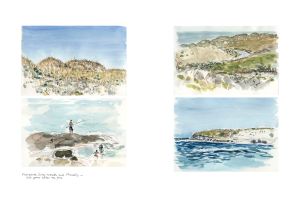
A work by Tom Carment
Are you planning to do any more long bushwalks?
I’d like to do some in NT and Qld. Carnarvon Gorge. Larapinta. Hinchenbrook Island. Katherine to Edith Falls.
Elizabeth Fortescue, December 9, 2014, Sydney
